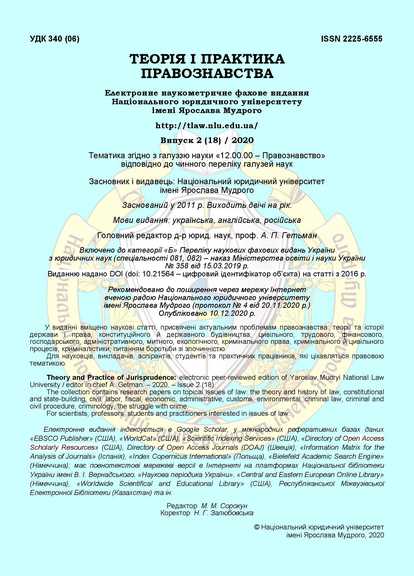Declaratory Theory of Common Law: Past and Present
DOI:
https://doi.org/10.21564/2225-6555.2020.18.216793Keywords:
declaratory theory of common law, judicial law making, judicial precedent, common law, temporal effect of judicial precedent, retrospectivityAbstract
The aim of the article is to analyze doctrinal views on the role of judges in lawmaking in common law systems – in terms of declaratory theory of common law, including the transformation of views on declaratory theory, clarify its current meaning and place in the doctrine and practice of common law.
The article provides the key provisions of the declaratory theory, criticism of supporters of law-making theory, as well as analysis of the views of opponents of the complete denial of the essence of this theory. Attention is paid to certain factors that contributed to the theory in the past - the role of customs and ideas of reason, justice in the history of the emergence and formation of common law. The connections of the given theories with different approaches to legal understanding are also shown.
The author explores the modern attitude towards the declaratory theory and the possible practical application of some of its constituent ideas. In particular, it is analyzed to which extent the activities of modern judges continue to be and is seen as an application of the existing law, rather than as the creation of a new one. In this regard, attention is paid to the role of the law principles in the justification of court decisions. In addition, the use of retrospectivity of common law has been traced, which is widely believed to be a legacy of this theory.
The article concludes that the statements about the attribution of declaratory theory to the past are categorical and exaggerated. Despite rejecting its key idea and acknowledging that the courts are in one way or another creating common law, it to some extent continues to retain its connection with the ideas of declaratory theory in a rethought form. This connection can be traced in the fact that the norms created by the courts are usually a moderate development of the current law, the specification of its principles, and thus have retrospectivityReferences
Alschuler, A. (1996). Rediscovering Blackstone. University of Pennsylvania Law Review, vol. 145, 1, 1–55. Doi: https://doi.org/10.2307/3312712.
Beever, A. (2013). The Declaratory Theory of Law. Oxford Journal of Legal Studies, vol. 33, 3, 421–444. Doi: https://doi.org/10.1093/ojls/gqt007.
Bingham, T. (2000). The Judge as Lawmaker: An English Perspective. The business of judging: selected essays and speeches. Oxford: Oxford University Press. 25–34. URL: https://www.semanticscholar.org/paper/The-Judge-as-Lawmaker%3A-An-English-Perspective*-Bingham/18d267b33ffc3825b3fe44154ba4d222a655a5c4.
Blackstone, W. (1893). Commentaries on the Laws of England, vol. 1. Philadelphia: J.B. Lippincott Co. URL: http://files.libertyfund.org/files/2140/Blackstone_1387-01_EBk_v6.0.pdf.
Brewbaker, William. (2006). Found Law, Made Law and Creation: Reconsidering Blackstone’s Declaratory Theory. Journal of Law and Religion, vol. 22, 1, 255–286. URL: https://papers.ssrn.com/sol3/papers.cfm?abstract_id=899103.
Donoghue v Stevenson [1932] AC 562 (HL Sc). URL: http://www.bailii.org/uk/cases/UKHL/1932/100.html.
Goff, Lord. (2012). Judge, Jurist and Legislature. The Denning Law Journal, vol. 2, 1, 79–95. Doi: https://doi.org/10.5750/dlj.v2i1.160.
Hale, M. (1820). The History of the Common Law of England. 6th ed. London. URL: https://books.google.com.ua/books?id=rktDAAAAcAAJ&printsec=frontcover&hl=uk#v= onepage&q&f=false.
Hammer, S.J. (2018), Retroactivity And Restraint: An Anglo-American Comparison. Harvard journal of law & public policy, vol. 41, 1, 409–442.
Harper v. Virginia Dept. of Taxation, 509 U.S. 86 (1993). URL: https://supreme.justia. com/cases/federal/us/509/86/.
Hodge Lord. (2019). The scope of judicial law-making in the common law tradition. Max Planck Institute of Comparative and International Private Law. Hamburg, Germany, 28 October 2019, 1–18. URL: https://www.supremecourt.uk/docs/speech-191028.pdf.
James M. Beam Distilling Co. v. Georgia, 501 U.S. 529 (1991). URL: https://supreme.justia.com/cases/federal/us/501/529/.
Kleinwort Benson Ltd v Lincoln City Council (1999)2 AC349 (HL). URL: https://www.trans-lex.org/310700/_/kleinwort-benson-ltd-v-lincoln-city-council-et-al%5B1999% 5D-2-ac-349/.
Levy, B.H. (1960). Realist Jurisprudence and Prospective Overruling. University of Pennsylvania Law Review, vol. 109, 1, 1–30.
15. McManus, R. (2007). Predicting the Past: The Declaratory Theory of the Common Law – From Fairytale to Nightmare. Judicial Review, vol. 12, 4, 228–245.
Pannick, D. (1980). A Note on Dworkin and Precedent. The Modern Law Review, vol. 43, 1, 36–44. URL: https://onlinelibrary.wiley.com/doi/pdf/10.1111/j.1468-2230.1980.tb01581.x.
Reid, Lord. (1972). The Judge as Lawmaker. Journal of the Society of Public Teachers of Law (New Series), vol. 12, 1, 22–29.
Scottish Law Commission (Scot. Law Com. No 169). (1999). Report on Unjustified Enrichment, Error of Law and Public Authority Receipts and Disbursements. Edinburgh: The Stationery Office. URL: https://www.scotlawcom.gov.uk/files/5712/7989/6662/rep169.pdf.
Scottish Law Commission. (1996). Judicial Abolition of the Error of Law Rule and its Aftermath. Edinburgh,. DP No 99. URL: https://www.scotlawcom.gov.uk/files/1213/1713/1950/dp99.pdf.
The Law Commission (Law Com. No. 227). (1994). Restitution: Mistakes of Law and Ultra Vires Public Authority Receipts and Payments. Report on a Reference Under Section 3 (1) (e) of the Law Commissions Act 1965. London: HMSO. URL: https://s3-eu-west-2.amazonaws.com/lawcom-prod-storage-11jsxou24uy7q/uploads/2015/06/lc227.pdf.
Troop, P. (2018). Why Legal Formalism Is Not a Stupid Thing: Legal Formalism. Ratio Juris, vol. 31, 4, 428–443. Doi: https://doi.org/10.1111/raju.12225.
Zamulinski, B. (2014). Rehabilitating the Declaratory Theory of the Common Law. Journal of Law and Courts, 2, 171–186. Doi: https://doi.org/10.1086/673873.
Barak, A. (1999). Sudejskoe usmotrenie. Moscow: Norma [in Russian].
Dvorkin, R. (2004). O pravah vseriez Moskva: Rossijskaja politicheskaja jenciklopedija (ROSSPEN) [in Russian].
Cross, R. (1985). Pretsedent v anhliyskom prave. Moscow [in Russian].
Malyshev, B.V. (2001). Pretsedentne pravo Anhlii: teoretychni aspekty. Naukovi zapysky NaUKMA – NAUKMA Research papers, vol. 19: Special issue, 1, 232–238 [in Ukrainian].
Malyshev, B.V. (2002). Sudovyi pretsedent u pravoviy systemi Anhliyi (teoretyko-pravovyi aspekt): Candidate’s thesis. Kyiv: KNU [in Ukrainian].
Pohrebniak, S.P. (2008). Osnovopolozhni pryntsypy prava (zmistovna kharakterystyka). Kharkiv: Pravo [in Ukrainian].
Shevchuk, S. (2007). Sudova pravotvorchist: svitovyi dosvid i perspektyvy v Ukrayini. Kyiv: Referat [in Ukrainian]
Downloads
Published
How to Cite
Issue
Section
License
Copyright (c) 2020 Олексій Пушняк

This work is licensed under a Creative Commons Attribution 4.0 International License.




